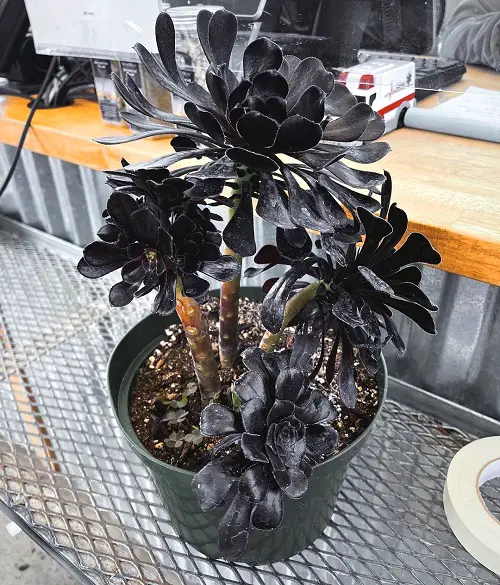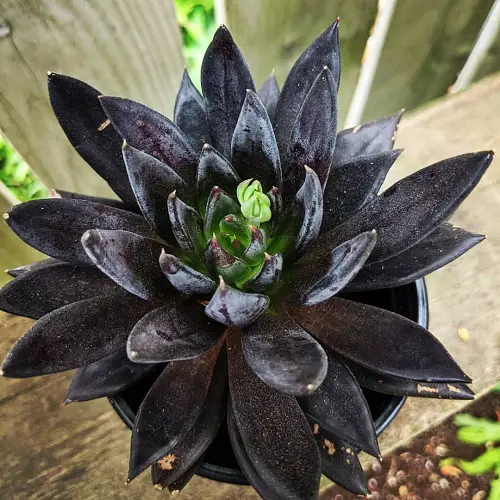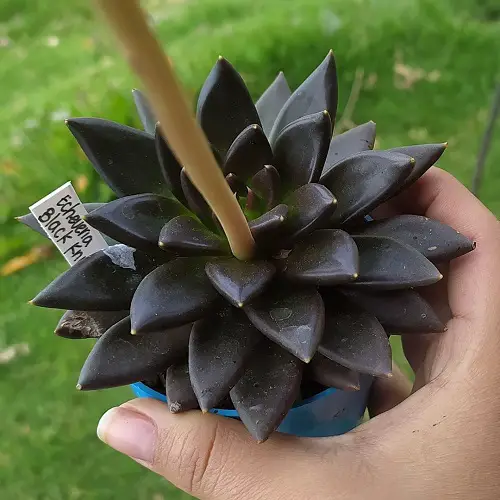Follow these effective commercial grower tips on How to Keep Black Succulents Blacker and add more drama to your plant collection.

Looking to add a touch of mystery and drama to your plant collection? Black succulents can be the perfect choice, with their deep, dark hues adding an intriguing allure to any space. However, keeping these succulents “blacker” requires some specialized care and attention. In this guide, we’ll delve into the tips and techniques used by commercial growers to maintain and enhance the intense black pigment in succulents like ‘Black Prince’ or ‘Black Knight.’
From understanding the science behind leaf shedding to exploring the impact of seasonal changes and optimizing environmental factors, we’ll cover everything you need to know to keep your black succulents looking their best. Whether you’re a seasoned succulent enthusiast or just starting your collection, these expert tips will help you achieve and maintain those captivating dark tones for a stunning display.
How to Keep Black Succulents Blacker

1. The Science Behind Leaf Shedding
No need to panic if varieties like ‘Black Prince’ or ‘Black Knight’ start shedding bottom leaves – it’s just their natural growth process and way of preserving energy. Many succulent varieties will shed older lower leaves as the plant matures and grows taller.
The shedding occurs because the lower leaves aren’t receiving as much sunlight and nutrients as the upper, more compact leaves. This leaf loss interestingly enhances the dark coloration of the remaining foliage on black succulents.
However, watch out for excessive, rapid leaf drop, which could signal distress from underwatering, overwatering, excessive heat, or cold.
2. Use Dark-Colored Planters
You read that right – the color of your planter can impact your succulent’s shade! This nifty trick plays on the heat absorption properties of different colors. Dark pots and containers absorb and retain more heat from sunlight compared to lighter-colored ones.
By using a black, deep purple, or charcoal gray planter, you essentially create a little oven of warmth around your succulent’s roots and soil. The increased heat exposure stresses the plant just enough to stimulate greater production of pigments like anthocyanins and betalains that give black succulents their rich, vampy tones.
3. Impact of Seasonal Changes
The shade of black succulent changes with the season. In cool months, the dark pigment intensifies due to dormancy. On the contrary, during warm months, the color of black succulents turns lighter. The science behind this transition is when the temperature cools down, the succulent retrieves the dark hue. To benefit from this, you can keep your black succulents in a cool area. Most black succulent varieties will intensify their dark pigmentation when kept between 50°F to 65°F (10°C to 18°C) during the cooler months.
Note: However, rapid temperature fluctuations or prolonged periods much below 50°F can cause stress. An ideal consistent cool temperature of 55°F to 60°F usually provides the optimal environment for great color enhancement without risking cold damage.
4. Keep Them in Stress
You can achieve a dark hue in succulents by keeping them under a bit of stress. Just increase the amount of sunlight exposure or decrease the watering. Do remember not to overstress the plant as it can harm the plant.
5. Pruning for Pigmentation

Pruning can also help in making the succulent darker. Just make a clean cut on the stem at 45-angle to stop water from accumulating at the cut place. Pruning can promote bushier, more compact growth by removing the growing tips. The shorter internodes and more condensed growth habit allows the plant’s pigments to be more concentrated, appearing even darker.
6. Experiment with Light Varieties
There is no doubt that natural sunlight is ideal for any plant, but the range of light can impact the succulents they are grown under.
For example, artificial lights, such as full-spectrum LED grow lights, can boost the dark pigment in black succulents. Try to use supplement natural light with these sources in dark months.
7. Execute a Cooling Period
Some black succulent varieties like ‘Black Rose’ or Aeonium arboreum ‘Zwartkop’ react to cold temperatures with improved pigmentation.
Provide a ‘cooling period’ during the late fall or early winter. Place it under a cool room or windowsill when the temperature falls around 50-55 F at night.
8. Choose a Specific Fertilizer or Try Iron Supplements
Certain fertilizers and supplements can give your black succulents an extra pigment-boosting kick. The key is to look for products that increase the production of anthocyanins – the reddish-purple pigments that lend richness to many black varieties.
The Espoma Organic Succulent Plant Food is a great option. After applying, you’ll see deeper, more saturated burgundies, plums, and near-blacks.
Another path to inky perfection? Supplementing with chelated iron because iron plays a key role in the production of anthocyanin pigments that give them their deep purple, red, or black hues.
Just be cautious of over-fertilizing, which can lead to fertilizer burn or excessive growth. Always follow product instructions, and cease treatments if you notice signs of stress like Browning leaf tips.
Note: Blend 1-2 oz of ferrous sulfate in one gallon of water. Then, water your plants with this solution every few weeks during the growing season. You’ll see faded black rosettes deepen into lush, luxurious tones.
9. Try Charcoal Additives
You can add horticultural charcoal to the soil. Charcoal additives can help make black succulents appear even darker by providing a contrasting black background that enhances the perception of their dark pigmentation. This rare trick is quite effective.
10. Adjust Water Quality
The type of water you are using to irrigate the plants also affects the color of succulents. Water with high minerals or hard water leaves residue on the foliage and impacts the color. For dark colors, always use filtered or distilled water.
With the right soil, water, and climate conditions – plus a little creativity – you can uncoverthe truedramatics potential of yourblack suculent collection. So have fun experimenting with these commercial grower tips, and get ready to wow your plant-loving friends with those smoldering, vampy hues! Who knew being a little goth could be so gorgeous?

